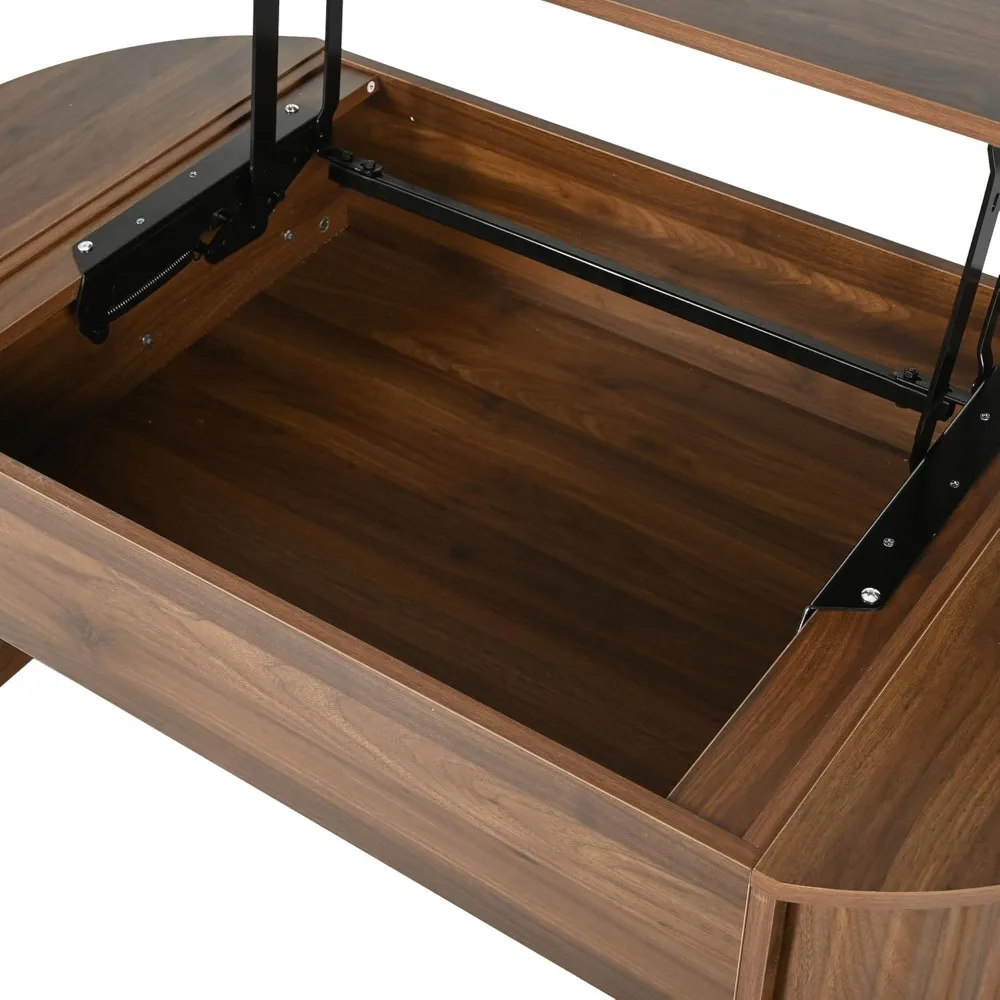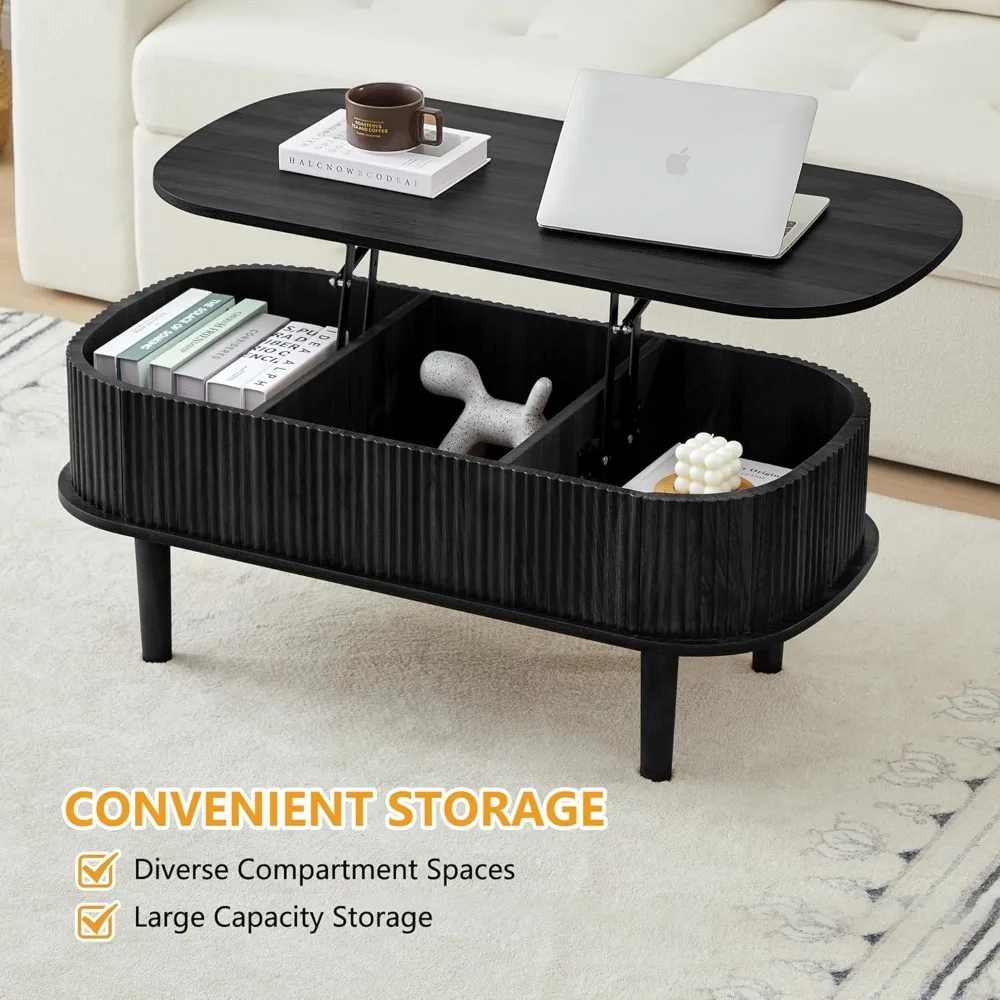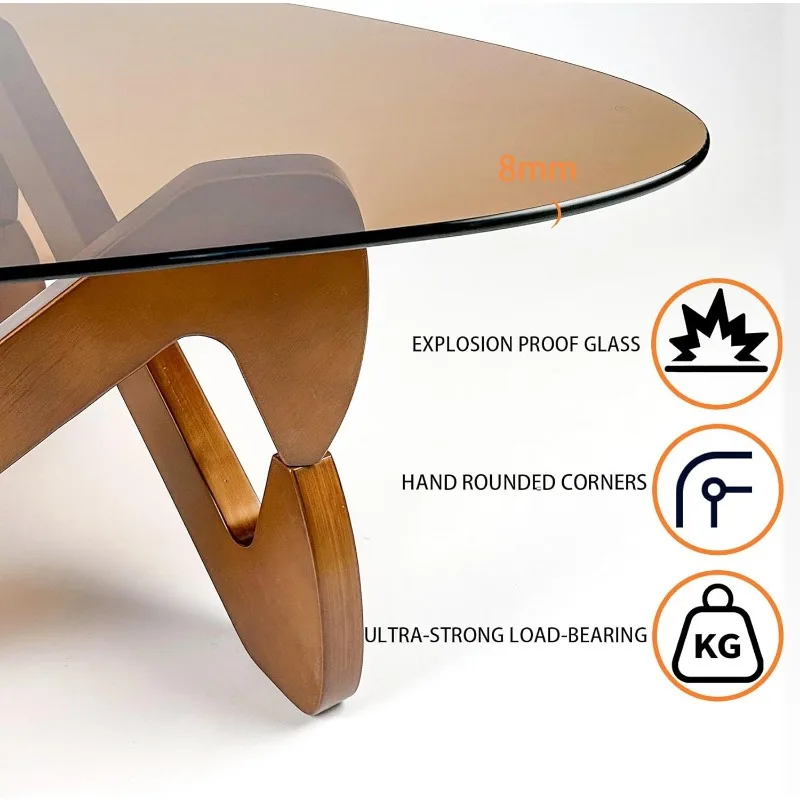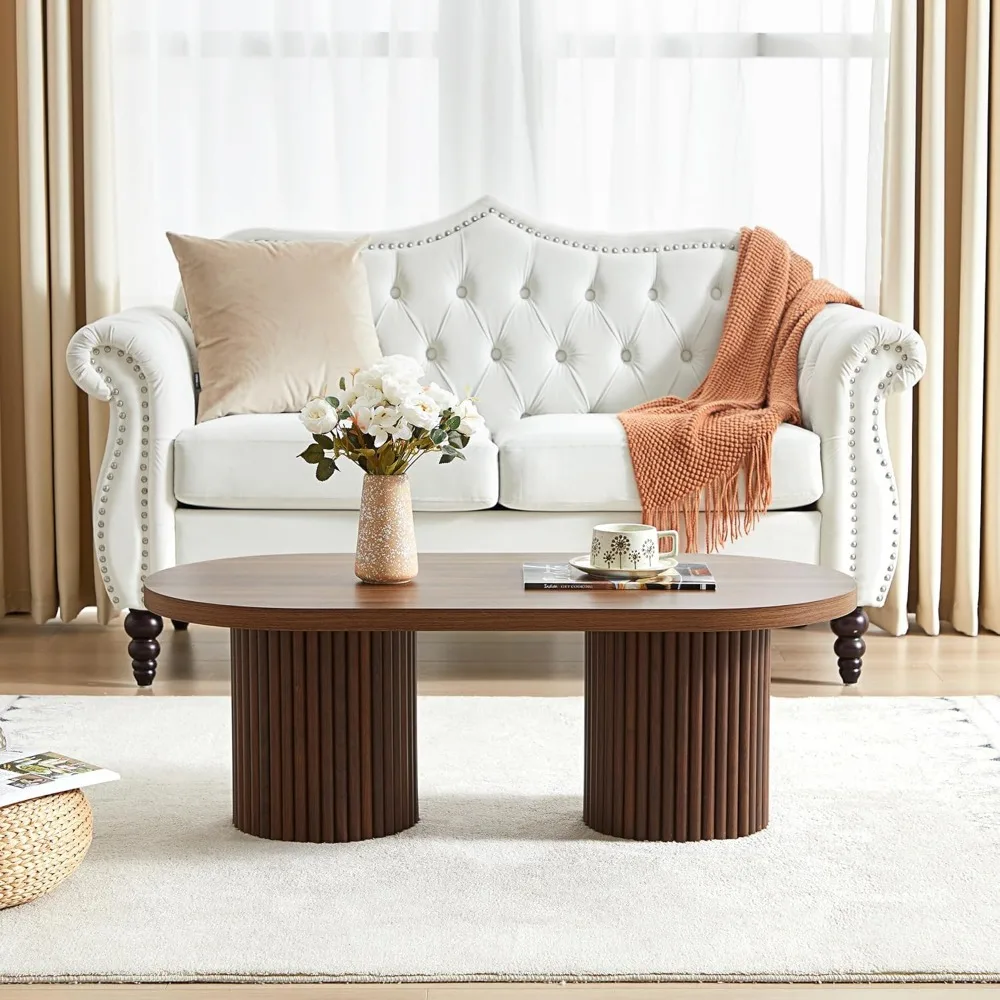Understanding the Icon: Essential Elements of Mid-Century Oval Coffee Tables
Mid-century oval coffee tables represent one of the most recognizable furniture elements from the golden age of modern design (1940s-1970s). These iconic pieces emerged during a period when function met artistic expression, resulting in furniture that was both practical and beautiful. At their core, these tables embody a design philosophy centered on simplicity, organic forms, and honest materials.
What truly defines a mid-century oval coffee table is a combination of distinctive characteristics:
- Clean, uncluttered lines that emphasize form over decoration
- Organic, flowing shapes that soften living spaces
- Functional design that prioritizes everyday usability
- Thoughtful proportions that create visual balance
The materials used in authentic mid-century pieces tell their own story. Rich, warm woods like walnut, teak, and rosewood dominate, often paired with glass tops, marble surfaces, or metal accents. These material combinations weren’t random—they were deliberately chosen to highlight natural beauty while creating visual contrast and interest.
The oval shape itself offers distinct advantages in interior spaces. Unlike rectangular tables with sharp corners, the gentle curve of an oval creates better traffic flow around the furniture. This improved circulation makes oval coffee table trends particularly relevant for contemporary homes where versatility matters. The soft, continuous edge is safer in households with children and creates a sense of visual harmony that rectangular shapes sometimes lack.
Understanding the design features of oval-shaped tables reveals how they differ fundamentally from other periods. While earlier furniture often featured heavy ornamentation and later styles embraced industrial elements, mid-century oval tables occupy a sweet spot where function, simplicity, and organic form converge. These tables aren’t merely functional pieces—they’re sculptural elements that enhance room flow while serving everyday needs.
For those seeking to add authentic design to their homes, our collection of mid-century modern oval coffee tables captures these essential elements while maintaining the quality and craftsmanship that defined the original era.
Masters of the Form: Iconic Designers and Their Legendary Creations
The evolution of oval coffee tables in mid-century design is inseparable from the visionaries who pioneered their most iconic forms. These master designers weren’t simply creating furniture—they were reshaping how we think about domestic spaces.
Isamu Noguchi: Sculptor of Functional Art
Noguchi’s IN-50 table (often simply called the “Noguchi Table”) perfectly illustrates the marriage between sculpture and function. With its biomorphic glass top resting upon an intricately sculpted wooden base, this piece challenges conventional notions of what a coffee table should be. Noguchi approached furniture design with an artist’s sensibility, creating balanced asymmetry that seems to defy gravity while remaining perfectly functional.
The table’s organic shape flows like water, with no beginning or end, demonstrating how oval and elliptical forms can create a sense of continuous motion within a static piece. What makes Noguchi’s work especially significant is how it bridged Eastern and Western design philosophies, bringing a sense of zen-like harmony to modern spaces.
Eero Saarinen: Engineering Elegance
Saarinen’s Oval Tulip Table represented a revolutionary departure from traditional table design. Declaring war on what he called the “slum of legs” found under most tables, Saarinen created a pedestal base that eliminated clutter and allowed for free movement around the table. This single sculptural pedestal supporting an oval top created a sense of visual lightness that contrasted dramatically with heavier furniture traditions.
The table’s sweeping, continuous form was achieved through innovative material applications, using molded aluminum for the base and natural stone or laminate for the top. This combination of industrial production methods with elegant forms helped define what mid-century modern furniture could be: both mass-producible and individually distinctive.
Charles and Ray Eames: Playful Functionality
The Eames’ ETR (Elliptical Table Rod) “Surfboard” table exemplifies their playful approach to furniture design. The dramatically elongated elliptical form paired with a wire base structure created a piece that seemed to float in space. This table wasn’t just functional—it brought a sense of California optimism and casual elegance to interior spaces.
What made the Eames approach so influential was their willingness to experiment with new materials and production techniques, creating designs that could be manufactured efficiently without sacrificing quality or aesthetic appeal.
Lesser-known but equally influential designers like Finn Juhl, Hans Wegner, and Greta Grossman also contributed significantly to the oval table legacy. Their work, often featuring Danish coffee table designs, emphasized craftsmanship and organic forms that continue to influence furniture design today.
These iconic designs didn’t merely exist in their time—they established enduring principles that continue to shape contemporary furniture. The balance of form and function, the honest expression of materials, and the emphasis on clean lines have become foundational elements of good design that transcend passing trends.
Modern Revival: Today’s Trends in Oval Mid-Century Tables
The resurgence of mid-century design hasn’t simply replicated the past—it has reimagined classic elements for contemporary living. Today’s oval coffee tables maintain the soul of mid-century design while incorporating modern materials, production techniques, and lifestyle considerations.
Contemporary Interpretations of Classic Forms
Modern designers have embraced the core principles of mid-century design—clean lines, organic shapes, and functional beauty—while adapting them to current tastes. Today’s interpretations often feature:
- Slimmer profiles for smaller living spaces
- Height adjustability for versatile use
- Integrated technology accommodations
- Enhanced storage solutions
These adaptations acknowledge changing lifestyles while preserving the essential character that makes mid-century design so enduring.
Material Trends and Innovations
While traditional woods remain popular, today’s material palette has expanded considerably:
- Mixed-material tops combining wood with marble, concrete, or terrazzo
- Sustainable woods like bamboo, acacia, and reclaimed timber
- Innovative finishes that enhance durability while preserving natural appearance
- Engineered surfaces that mimic natural materials while offering superior performance
The finish choices have evolved as well, with matte surfaces often replacing high-gloss treatments, and warm metals like brass and copper complementing traditional woods. These material combinations create visual interest while maintaining the harmonious balance that defines mid-century aesthetics.

Silhouette Evolution
Modern interpretations have introduced subtle variations to classic oval forms:
- Asymmetrical oval shapes that create visual interest
- Sculptural, statement-making bases that become focal points
- Nesting configurations that provide flexibility in smaller spaces
- Organic, imperfect ovals that emphasize handcraftsmanship
These silhouette variations maintain the flowing, organic quality of traditional oval tables while introducing contemporary visual interest. Mastering mid-century oval coffee table arrangements has become easier with these adaptable designs.
Sustainability Focus
Perhaps the most significant evolution in mid-century oval tables is the emphasis on sustainability. Today’s designs often feature:
- FSC-certified woods from responsibly managed forests
- Water-based, low-VOC finishes
- Recycled or upcycled materials
- Construction methods that enable repair rather than replacement
This sustainability focus aligns perfectly with the mid-century ethos of creating furniture built to last generations rather than seasons.
The integration of oval mid-century tables with complementary design movements like Japandi (Japanese-Scandinavian fusion) and Warm Minimalism demonstrates their remarkable versatility. The clean lines and natural materials of round and oval mid-century coffee tables work harmoniously with these related aesthetics, allowing for personalized interpretations of timeless design.
Our collection of mid-century modern lift-top coffee tables showcases how contemporary functional needs can be beautifully integrated with classic mid-century forms.
Styling Your Statement Piece: Design Integration Techniques
An oval mid-century coffee table is more than just furniture—it’s a focal point that anchors your living space. Successful styling begins with thoughtful placement and extends to creating a harmonious relationship with surrounding elements.
Space Planning Essentials
The proper placement of an oval coffee table creates balance and ensures functionality:
- Allow 12-18 inches between the table and seating for comfortable leg room
- Center the table within the seating arrangement rather than the room itself
- Consider traffic patterns—the oval shape naturally guides movement around it
- Scale the table appropriately—it should be approximately two-thirds the length of your sofa
These placement principles ensure your coffee table serves both its aesthetic and functional purposes without disrupting the flow of your space.
Creating Balance with Surrounding Furniture
The oval coffee table works best when it maintains a visual dialogue with other pieces:
- Pair curved tables with straight-lined seating for pleasing contrast
- Balance heavy upholstery with lighter table designs
- Create cohesion through repeated materials or colors
- Consider scale relationships—a substantial sofa pairs well with a visually substantial table
The relationship between your coffee table and other furniture creates the foundation for a cohesive design story in your living space.
Surface Styling Approaches
The art of perfectly styling an oval coffee table transforms it from mere furniture to a personal expression:
- Create balanced asymmetry with varied heights and textures
- Establish a central focal point (like a substantial bowl or sculptural object)
- Layer items from large to small, back to front
- Include personal elements that tell your story
- Maintain negative space—don’t overcrowd the surface
Plants add life to table styling—consider low-profile varieties like succulents or air plants that won’t obstruct sightlines across the table.

Rug Selection and Placement
The right rug creates a foundation for your coffee table and seating arrangement:
- Choose a rug large enough to accommodate all furniture legs
- Consider texture contrast—pair smooth tables with textured rugs
- Echo table shapes with oval or round rugs for harmony, or contrast with rectangular rugs
- Allow the rug pattern to complement rather than compete with your table
Lighting Considerations
Strategic lighting enhances the presence of your oval coffee table:
- Position floor lamps at angles that highlight the table’s shape
- Consider how natural light interacts with wood tones throughout the day
- Use table lamps on nearby surfaces to create ambient lighting that showcases the table
- For glass or marble-topped tables, consider how light reflects off the surface
For those seeking quality pieces that respond beautifully to thoughtful styling, our mid-century modern solid wood coffee tables offer exceptional material quality that becomes even more beautiful with proper care and arrangement.
The Authenticity Question: Vintage Originals vs. Contemporary Productions
Understanding the spectrum between vintage originals and contemporary productions helps collectors and casual buyers alike make informed decisions about their mid-century oval coffee tables.
Defining the Categories
The market for mid-century oval coffee tables generally falls into three categories:
- Original Vintage: Pieces manufactured during the mid-century period (approximately 1940s-1970s)
- Licensed Reproductions: New pieces produced with permission from original designers’ estates or rights holders
- Inspired Pieces: Contemporary designs that reference mid-century aesthetics without directly copying specific pieces
Each category offers different benefits in terms of authenticity, price, condition, and availability.
Identifying Authentic Vintage Pieces
True vintage mid-century oval tables often reveal their authenticity through several key indicators:
- Construction details like dovetail or finger joints in drawers
- Original hardware with distinctive patina
- Maker’s marks, stamps, or labels (often on the underside)
- Material characteristics specific to the era (certain wood grains, glass thickness)
- Natural patina development on wood surfaces
- Age-appropriate wear patterns on bases and edges
These details tell the story of a piece’s history and confirm its authentic vintage status.
Evaluating Contemporary Reproductions
Quality contemporary pieces, whether licensed reproductions or inspired designs, have their own markers of excellence:
- Attention to original proportions and dimensions
- Material quality comparable to original specifications
- Structural integrity and weight similar to vintage pieces
- Precise joinery and finishing details
- Hardware that honors original designs
Reputable manufacturers of contemporary mid-century pieces prioritize these quality indicators, creating furniture that carries forward the design legacy while offering modern advantages like structural guarantees and consistent availability.
Price Expectations and Value Propositions
Understanding price variations across these categories helps set realistic expectations:
- Original designer pieces in excellent condition command premium prices due to provenance and rarity
- Licensed reproductions typically cost less than originals but more than inspired pieces
- Quality inspired pieces offer the best value for those seeking the aesthetic without historical significance
- Restoration costs should be factored into vintage purchase decisions
For those seeking the mid-century aesthetic with contemporary quality guarantees, our vintage-inspired coffee tables offer excellent craftsmanship that honors the original design principles.
Smart Shopping: Essential Considerations for Your Purchase
Finding the perfect oval mid-century coffee table requires thoughtful evaluation of several key factors that will determine how well the piece serves your needs and space.
Budget Planning Across Quality Tiers
Setting realistic budget expectations helps narrow your search effectively:
- Entry-level inspired pieces: $300-800
- Mid-range quality reproductions: $800-2,000
- High-end licensed reproductions: $2,000-5,000
- Authentic vintage pieces: $1,500-15,000+ depending on designer and condition
Consider your purchase timeline—sometimes waiting and saving for a higher-quality piece yields better long-term satisfaction than compromising on an immediate purchase.
Size and Proportion Guidelines
Selecting the right dimensions ensures your table fits both physically and visually in your space:
- For standard three-seat sofas (72-84 inches), look for oval tables 48-60 inches long
- Allow minimum 30 inches between the table edge and other furniture or walls
- Consider height relationship—coffee tables typically sit 1-2 inches below cushion height
- Account for proportional width—oval tables typically range from 22-30 inches wide
Understanding where to buy oval mid-century coffee tables with the right dimensions for your space ensures a successful purchase.
Material Selection Based on Lifestyle
Different materials suit different household situations:
- Solid wood: Durable but requires protection from moisture and heat
- Glass tops: Create visual lightness but show fingerprints and require frequent cleaning
- Stone tops: Offer elegance and durability but can be heavy and susceptible to staining
- Laminate surfaces: Provide affordability and easy maintenance but lack the authenticity of natural materials
When comparing options, the debate between oval vs. rectangular coffee tables often comes down to both aesthetic preference and practical considerations about space and usage patterns.
Assessing Craftsmanship Quality
Key quality indicators to evaluate before purchasing include:
- Solid construction with minimal wobble or movement
- Smooth drawer operation if applicable
- Consistent finish application without bubbles or uneven coloration
- Tight, clean joinery where components meet
- Appropriate weight relative to size and materials
- Even leg contact with the floor (no rocking)
These factors affect both the immediate appeal and long-term durability of your investment.
Where to Shop
Different retail channels offer distinct advantages:
- Specialty furniture retailers: Expert guidance and curated selection
- Vintage dealers: Authentic pieces with history and character
- Online marketplaces: Wide selection and competitive pricing
- Auction houses: Opportunity for unique finds with provenance
Mid-Century Modern Solid Wood Coffee Tables, Mid-Century Modern Teak Coffee Tables
$879.95 Select options This product has multiple variants. The options may be chosen on the product pageMid-Century Modern Danish Coffee Tables, Mid-Century Modern Oval Coffee Tables, Mid-Century Modern Solid Wood Coffee Tables
$390.05 Select options This product has multiple variants. The options may be chosen on the product pageMid-Century Modern Coffee & End Table Sets, Mid-Century Modern Coffee Table Sets, Mid-Century Modern Oval Coffee Tables
Price range: $257.48 through $331.04 Select options This product has multiple variants. The options may be chosen on the product pageMid-Century Modern Glass Top Coffee Tables, Mid-Century Modern Glass Top Side & End Tables
$460.58 Select options This product has multiple variants. The options may be chosen on the product pageMid-Century Modern Glass Top Coffee Tables, Mid-Century Modern Vintage Coffee Tables, Mid-Century Modern Vintage Side & End Tables
$725.36 Select options This product has multiple variants. The options may be chosen on the product pageMid-Century Modern Lift Top Coffee Tables, Mid-Century Modern Square Coffee Tables
$454.73 Select options This product has multiple variants. The options may be chosen on the product page
At Hearth Forms, we carefully evaluate each piece against strict criteria for design authenticity and quality construction, ensuring our customers receive furniture that honors true mid-century principles.
Beyond the Living Room: Creative Applications for Oval Coffee Tables
The versatility of oval mid-century coffee tables extends far beyond their traditional living room role, offering creative opportunities throughout the home.
Non-Traditional Placements
Consider these unexpected locations for your oval coffee table:
- Bedroom seating areas create intimate conversation spaces
- Home office lounges provide informal meeting spaces away from the desk
- Entryway focal points offer both function and first impression style
- Sunroom centerpieces bring organized structure to relaxation areas
These alternative placements leverage the table’s flowing form to create inviting spaces in unexpected locations.
Multi-Functional Applications
Modern living demands furniture that performs multiple functions:
- Occasional dining surfaces for casual meals
- Work-from-home stations when traditional desks feel too formal
- Display platforms for rotating art or collections
- Game tables for family entertainment
The open surface area of oval tables makes them particularly suited to these versatile applications.

Scale Adaptations
Different sized oval tables serve distinct purposes beyond the living room:
- Smaller tables (under 36 inches) work beautifully in reading nooks
- Medium tables (36-48 inches) function well in home office seating areas
- Larger tables (over 48 inches) can serve as conference alternatives in home offices
For spaces requiring transparency and visual lightness, our mid-century modern glass-top coffee tables offer versatile solutions that adapt to various room functions.
Unexpected Style Pairings
Mid-century oval tables demonstrate remarkable compatibility with diverse design styles:
- Traditional settings benefit from the contemporary contrast
- Industrial spaces gain warmth from wood elements
- Maximalist interiors receive structural grounding
- Contemporary spaces gain historical context and depth
This adaptability demonstrates why these designs remain relevant decades after their introduction.
The Enduring Appeal: Why Oval Mid-Century Tables Remain Relevant
The longevity of oval mid-century coffee tables in interior design speaks to something deeper than passing trends—these pieces connect with fundamental principles of good design that remain relevant across generations.
Timeless Design Principles
Several core attributes explain why these pieces continue to resonate:
- Human-centered proportions that relate comfortably to the body
- Honest material expression that celebrates natural beauty
- Balance between function and form without compromising either
- Visual lightness that prevents spaces from feeling heavy or crowded
These principles transcend specific eras, allowing mid-century pieces to integrate seamlessly into contemporary settings.
Versatility Across Design Styles
Few furniture styles demonstrate the chameleon-like adaptability of mid-century oval tables:
- They provide historical grounding in minimalist spaces
- Their clean lines complement contemporary interiors
- Their natural materials enhance biophilic design approaches
- Their sculptural qualities add interest to neutral palettes
This versatility ensures these pieces remain relevant as surrounding trends evolve.
Functional Advantages for Contemporary Living
The practical benefits of oval coffee tables align perfectly with modern lifestyle needs:
- Their lack of sharp corners creates safer environments for families
- Their flowing forms facilitate movement in smaller living spaces
- Their balanced proportions work well with today’s seating arrangements
- Their sculptural presence reduces the need for additional decorative elements
These functional advantages ensure oval mid-century tables continue serving practical needs while providing aesthetic benefits.
Caring for Your Investment: Maintenance and Preservation
Proper care ensures your oval mid-century coffee table remains beautiful for generations, preserving both its appearance and value.
Wood Care Essentials
Maintaining wooden components requires specific attention:
- Dust regularly with a soft, slightly damp cloth, following the wood grain
- Clean with mild soap solutions only when necessary, never saturating the wood
- Apply quality furniture wax or oil (appropriate to your specific finish) every 6-12 months
- Use coasters and placemats to prevent water rings and heat damage
- Position away from direct sunlight and heating vents to prevent fading and drying
Regular maintenance prevents most common issues that diminish both beauty and value.
Glass and Stone Maintenance
For tables with non-wood surfaces:
- Clean glass with ammonia-free glass cleaner and microfiber cloths to prevent streaking
- Treat natural stone with appropriate sealants every 6-12 months
- Address stone stains immediately with stone-specific cleaning products
- Use felt pads under items placed on glass or stone to prevent scratches
- Lift rather than drag objects across these surfaces
These specialized materials require different care routines than wood components.
Metal Component Care
Metal elements benefit from regular attention:
- Wipe chrome, steel, or brass components with a soft cloth
- Remove fingerprints from metal with appropriate metal cleaner
- Apply a thin coat of paste wax to brass components to prevent oxidation
- Check and tighten hardware periodically to maintain structural integrity
For those with walnut coffee tables, special attention to oil content in the wood helps maintain the rich, warm tones that make walnut so prized in mid-century furniture.
Restoration Considerations
When deeper care is needed:
- Consider professional restoration for valuable vintage pieces
- Evaluate refinishing options carefully—over-restoration can diminish value
- Document original condition before any significant restoration
- Research appropriate period-correct materials for repairs
A thoughtful approach to restoration preserves both the physical object and its historical integrity.
Is an Oval Mid-Century Coffee Table Right for You? Key Questions to Consider
Before making your final decision, consider these essential questions to determine if an oval mid-century coffee table aligns with your specific needs and circumstances.
Does it match your lifestyle needs?
- Do you need a piece that accommodates frequent entertaining?
- Is child safety a primary concern in your furniture selection?
- Will the table need to withstand heavy use or more careful treatment?
- Does your lifestyle require additional storage that some models provide?
Your honest assessment of daily use patterns helps determine the most appropriate table features.
Is your space compatible?
- Does your room size comfortably accommodate an oval table’s footprint?
- Will the oval shape improve traffic flow in your specific layout?
- Does your existing furniture complement the proportions of mid-century designs?
- Is your flooring suitable for the leg design of your preferred table?
The relationship between your space and your furniture significantly impacts both functionality and visual harmony.
Does it align with your design vision?
- Does mid-century aesthetic complement your overall interior direction?
- Will the warm tones of traditional woods work with your color palette?
- Does the balance of your room benefit from the organic shape of an oval?
- Will the table serve as a statement piece or supporting element?
Understanding the table’s role in your overall design helps guide specific selection decisions.
Choosing the perfect coffee table involves balancing practical considerations with aesthetic preferences. The right oval mid-century piece doesn’t just fill space—it enhances your daily living experience while expressing your personal style.
The enduring popularity of these iconic designs speaks to their remarkable ability to remain relevant across decades and design trends. Their combination of artistic expression and practical function represents the very best of what thoughtful design can achieve—beauty that serves purpose, and craftsmanship that stands the test of time.







